

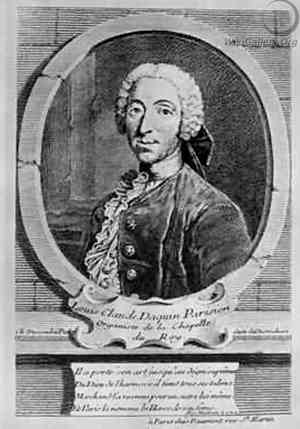
Louis-Claude Daquin
Source: Wiki Gallery
Born in Paris on 4 July 1694, Louis-Claude Daquin was a keyboard virtuoso mostly remembered for his noels. Noels had developed out of the motet (sacred polyphonic songs) composed especially for Christ Mass since the 13th century (though the first mention of "Christ Mass" was in 1038, very likely accompanied with chant or hymn, that about the time that hymns began to replace the Gregorian chant). The term's first use is thought to be circa 1420 by composer, Nicolas Grenon.
Daquin composed in both formal baroque and freer galant manners, the latter often used as a term for the late baroque of the 18th century before shifting into the classical period. Histories of the galant period (c 1710 to 1770) might commence with Francis Couperin (1668-1733), also mentioning Jean-Philippe Rameau (1683-1764) born a decade or so before Daquin. The galant period in music roughly coincides with rococo in architecture and art (c 1710-1770), both emerging in France to quickly spread throughout Europe to Russia. One might think of either as a lighter style arising out of a baroque that had spent the previous century becoming both formal and complex. Galant was much a return to the origins of baroque back around 1600 which aim had been to simplify composition, rescuing it from clever complications like polyphony too indulged, and emphasizing elegance along with meaning in song to which opera had become the new vehicle. Rococo originated in rocaille, a richly embellished French ornamental style of late Baroque. Come the eighteenth century, though regions Polish had fallen behind the rest of western Europe due to continual wars, more distant Russia was by now keeping pace. Helping to make certain of such was Russian Empress, Elizaveta Petrovna, daughter of Catherine I, so concerned to stay in step with the rest of Europe that in 1733 she demolished her mother's palace of 1717, already hopelessly behind the times, to show off an entirely rococo glory. Catherine I had been the second wife of Peter the Great.
Rococo Art & Architecture
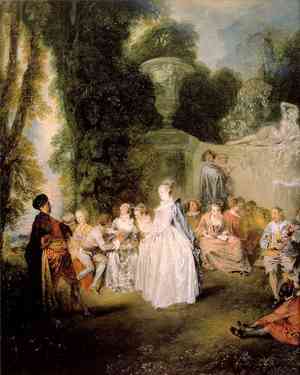
Venetian Pleasure
Painting by Jean-Antoine Watteau 1718
Source: 1st Art Gallery
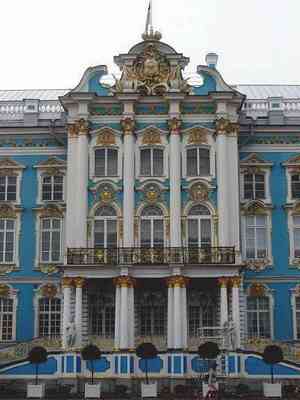
Summer Palace of Russian Empress Elizaveta Petrovna
Replacing the 1717 palace of Catherine I in 1733
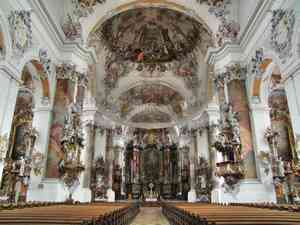
Ottobeuren Basilica in Bavaria
Construction 1737–1766
Source: Wonder Mondo
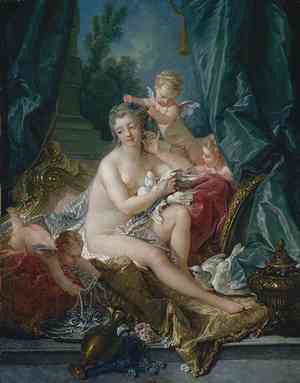
The Toilette of Venus
Painting by François Boucher 1751
Source: Met Museum
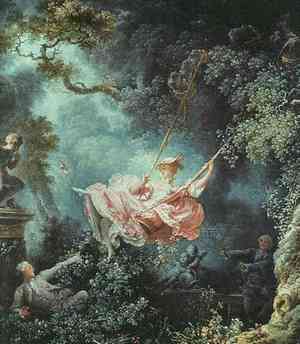
The Swing
Painting by Jean-Honoré Fragonard 1767
Source: Nany Zhang
Daquin's father, a painter, is said to have wrought a prodigy, Daquin performing at the court of King Louis XIV of France at age six. Two years later he conducted his choral work, 'Beatus Vir', then became a pupil of Louis Marchand for a time. At age twelve Daquin became organist at the Sainte-Chapelle, the following year at the Church of Petit Saint Antoine. In 1727 he acquired a position as organist at the Church of Saint Paul, at the Church of the Cordeliers in 1732. In 1739 he became organist to King Louis XV at the Chapelle Royale. He landed another nice pad upon becoming organist at Notre-Dame Cathedral in 1755. Albeit Daquin left behind no great corpus of works he did publish a couple of books. 'Pièces de Clavecin' of 1735 consisted of four suites followed by 'Les Plaisirs de la Chasse - Divertissement'. The other was his 'Livre de Noëls' for organ or harpsichord of 1757 consisting of twelve pieces.
No.15 of 'Pièces de Clavecin' Louis-Claude Daquin
'L'Hirondelle' from the Deuxième Suite
Published 1735 Harpsichord: Olivier Baumont
No.16 of 'Pièces de Clavecin' Louis-Claude Daquin
'Le Coucou' from the Troisième Suite
Published 1735 Harpsichord: George Malcolm
No.18 of 'Pièces de Clavecin' Louis-Claude Daquin
'L'Amusante' from the Troisième Suite
Published 1735 Harpsichord: Ernst Stolz
No.27 of 'Pièces de Clavecin' Louis-Claude Daquin
'Réjouissance des Chasseurs' (2 menuets) from 'Les Plaisirs de la Chasse - Divertissement'
Published 1735 Harpsichord: Céline Frisch
'Livre de Noëls' Louis-Claude Daquin
Published 1757 consisting of 12 pieces Organ: Olivier Baumont
Daquin died in Paris on 15 June 1772.
Sources & References for Louis-Claude Daquin:
James Reel (All Music)
VF History (notes)
Audio of Daquin:
Classical Archives Hyperion Naxos Presto
Recordings of Daquin (catalogs):
DAHR (shellac) Discogs Music Brainz RYM
Scores / Sheet Music:
Abe Books (vendor)
Musicalics (vendor)
Authority Search: VIAF
Sources & References for the Galant Period (C 1710-1770):
M. Tevfik Dorak LCS Productions Wikipedia
Sources & References for the Rococo Period (C 1710-1770):
Classical Main Menu Modern Recording
hmrproject (at) aol (dot) com